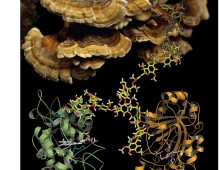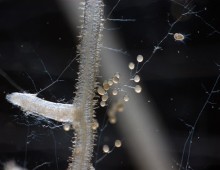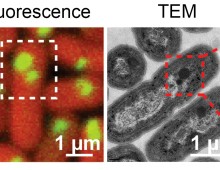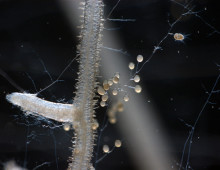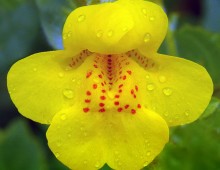Looking at a combination of whole genomes and gene databases suggests a new way to examine this fungus family tree. The Science: Researchers reviewed 10 currently available whole genomes, comparing them to known gene datasets. They reported family trees for several taxonomic subgroupings called clades. They also analyzed several single-copy genes to assess them for…
Fungi and plants working hand-in-hand
Genomic analysis of an ancient companion of plants shows expanded genes for phosphorus fixation and cell-to-cell communication The Science: More than two thirds of the world’s plants depend on arbuscular mycorrhizal fungi (AMF, also called glomeromycota) because of their ability to fix phosphorus. By analyzing the genome of one AMF, Rhizophagus irregularis (formerly Glomus intraradices),…
An insider’s view of bacterial assembly line
A combination of time-lapse fluorescence and transmission electron microscopy reveals how cyanobacteria put together an essential component The Science Cyanobacteria use carboxysomes to make their own energy by “fixing” carbon from carbon dioxide from ocean waters and other aquatic and terrestrial habitats. After deleting the genes cyanobacteria need to build carboxysomes, researchers introduced fluorescent-tagged components…
Mary Ann Moran, University of Georgia
Distinguished Research Professor, Department of Marine Sciences, University of Georgia Collaborated with JGI since 2007 We have been working with JGI on metatranscriptomic studies, using gene expression data to link activity, taxonomy, and function within marine microbial communities; and on model organism studies of bacteria-phytoplankton interactions in the ocean. The goal of our research is to identify…
Jeff Dangl, University of North Carolina
Howard Hughes Medical Institute (HHMI) investigator, University of North Carolina, John N. Couch Professor of Biology Collaborated with JGI since 2008 My lab has been engaged with JGI on a long-range project looking at the complex network of life of the microbiome that inhabits the rhizosphere and endosphere —the niches immediately surrounding and inside a plant’s root. Science…
Trina McMahon, University of Wisconsin-Madison
Professor of Bacteriology, Professor of Civil and Environmental Engineering, McMahon Lab, University of Wisconsin-Madison Collaborated with JGI since 2005 We have worked together on projects related to sewage treatment and freshwater lakes. Activated sludge wastewater treatment processes are used throughout the world to purify trillions of gallons of sewage annually. Many treatment plants employ specialized…
Project Management Office: Miranda Harmon-Smith
Miranda Harmon-Smith is in her ninth year at JGI, having started as a technician on the Sanger sequencing line before moving up, first to supervisor, then ultimately joining the PMO in 2012. It was her second “real” job after three years doing brain tumor research at the University of California, San Francisco and following her…
How Scavenging Fungi Became a Plant’s Best Friend
Glomeromycota is an ancient lineage of fungi that has a symbiotic relationship with roots that goes back nearly 420 million years to the earliest plants. More than two thirds of the world’s plants depend on this soil-dwelling symbiotic fungus to survive, including critical agricultural crops such as wheat, cassava, and rice. The analysis of the…
Monkeying around with gene shuffling
The iconic monkey flower’s genome harbors “hot spots” of genetic exchange The Science By analyzing the genomes of a wild population of Mimulus guttatus, also known as the monkey flower, researchers were able to pinpoint “hot spots” in the plant’s DNA code (http://www.archive.jgi.doe.gov/News/news_13_11_18.html with high rates of gene-shuffling recombination. They also provided a reference genome…
The Inner Workings of a Bacterial Black Box Caught on Time-lapse Video
Cyanobacteria, found in just about every ecosystem on Earth, are one of the few bacteria that can create their own energy through photosynthesis and “fix” carbon – from carbon dioxide molecules – and convert it into fuel inside of miniscule compartments called carboxysomes. Using a pioneering visualization method, researchers from the University of California, Berkeley,…
